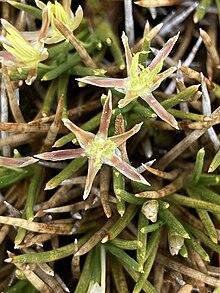
Nothoscordum is a genus of New World plants in the onion tribe within the Amaryllis family. It is probably paraphyletic. The genus is native to North, Central and South America, though a few species have become naturalized in various parts of the Old World.

Nothofagus, also known as the southern beeches, is a genus of 43 species of trees and shrubs native to the Southern Hemisphere in southern South America and east and southeast Australia, New Zealand, New Guinea, and New Caledonia. The species are ecological dominants in many temperate forests in these regions. Some species are reportedly naturalised in Germany and Great Britain. The genus has a rich fossil record of leaves, cupules, and pollen, with fossils extending into the late Cretaceous period and occurring in Australia, New Zealand, Antarctica, and South America.
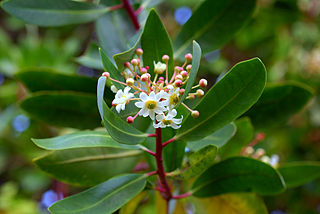
Drimys is a genus of seven species of woody evergreen flowering plants, in the family Winteraceae. The species are native to the Neotropics, ranging from southern Mexico to the southern tip of South America. They are primitive dicots, associated with the humid temperate Antarctic flora of the Southern Hemisphere, which evolved millions of years ago on the ancient supercontinent of Gondwana. Members of the family generally have aromatic bark and leaves, and some are used to extract essential oils.

Juncus is a genus of monocotyledonous flowering plants, commonly known as rushes. It is the largest genus in the family Juncaceae, containing around 300 species.

Luzula is a genus of flowering plants in the rush family Juncaceae. The genus has a cosmopolitan distribution, with species occurring throughout the world, especially in temperate regions, the Arctic, and higher elevation areas in the tropics. Plants of the genus are known commonly as wood-rush, wood rush, or woodrush. Possible origins of the genus name include the Italian lucciola or the Latin luzulae or luxulae, from lux ("light"), inspired by the way the plants sparkle when wet with dew. Another etymology sometimes given is that it does derive from lucciola but that this meant a mid-summer field, or from the Latin luculus, meaning a small place; the same source also states that this name was applied by Luigi Anguillara in 1561.

Schinus is a genus of flowering trees and tall shrubs in the sumac family, Anacardiaceae. Members of the genus are commonly known as pepper trees. The Peruvian pepper tree is the source of the spice known as pink peppercorn.

Deschampsia is a genus of plants in the grass family, commonly known as hair grass or tussock grass. The genus is widespread across many countries.

Olsynium is a genus of summer-dormant rhizomatous perennial flowering plants in the iris family Iridaceae, native to sunny hillsides in South America and western North America.
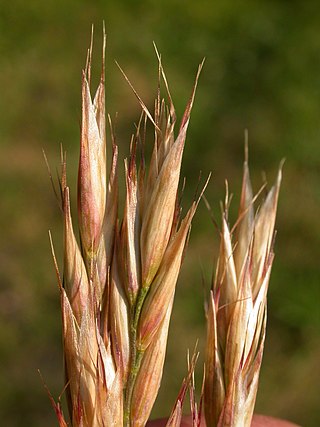
Danthonia is a genus of Eurasian, North African, and American plants in the grass family. Members of this genus are sometimes referred to as oatgrass, but that common name is not restricted to this genus. Other common names include heathgrass and wallaby grass. Australian species have since been reclassified into the genus Rytidosperma.

Rostkovia is a genus of flowering plants in the family Juncaceae. It was described in 1809.

The Antarctic Floristic Kingdom, also the Holantarctic Kingdom, is a floristic kingdom that includes most areas of the world south of 40°S latitude. It was first identified by botanist Ronald Good, and later by Armen Takhtajan. The Antarctic Floristic Kingdom is a classification in phytogeography, different from the Antarctic realm classification in biogeography, and from Antarctic flora genera/species classifications in botany.
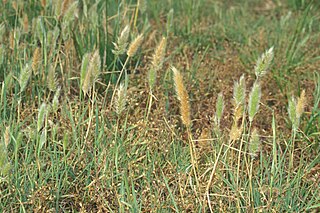
Polypogon is a nearly cosmopolitan genus of plants in the grass family, commonly known beard grass or rabbitsfoot grass.
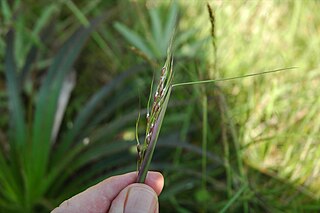
Piptochaetium, or speargrass, is a genus of plants in the grass family, native to North and South America. Piptochaetium is a bunchgrass genus in the tribe Stipeae.

Distichlis is a genus of American and Australian plants in the grass family. Plants in this genus are dioecious, have rhizomes or stolons, and have conspicuously distichous leaves.

Gavilea is a genus of flowering plants from the orchid family, Orchidaceae. It is native to Chile, Argentina and the Falkland Islands.

Leyesaurus is an extinct genus of massospondylid sauropodomorph dinosaur known from the San Juan Province, northwestern Argentina.

Tristagma is a genus of South American plants in the onion subfamily with the Amaryllis family. It is native to South America but one of the species (T. uniflorum) has become naturalized in various other places.

Distichia is a genus of plants in the family Juncaceae described as a genus in 1843.
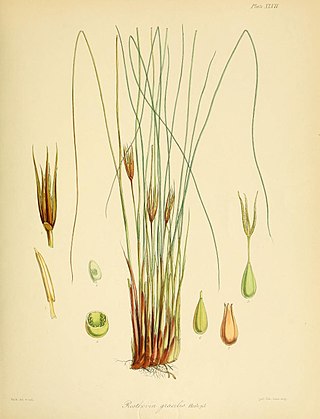
Marsippospermum is a genus of flowering plants in the family Juncaceae described in 1809.

Patosia is a monotypic genus of flowering plants in the family Juncaceae. It was described as a genus in 1890.
